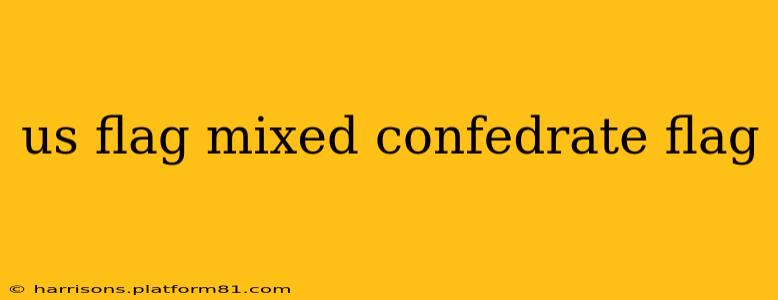The sight of a US flag displayed alongside a Confederate battle flag is undeniably complex and evokes strong reactions. It's a visual juxtaposition that sparks intense debate, raising questions about heritage, history, racism, and the very nature of American identity. Understanding the varied interpretations and the historical context is crucial to navigating this sensitive topic.
This article will explore the meaning behind combining these two potent symbols, examining the different perspectives and the often-painful realities associated with their coexistence.
Why do people display both the US and Confederate flags together?
The motivations behind displaying both flags together are varied and often intertwined. Some proponents claim it represents their Southern heritage and pride in their ancestors, regardless of their involvement in the Confederacy. They see the Confederate flag as a symbol of regional identity, distinct from any endorsement of slavery or white supremacy. Others believe it represents a rejection of what they perceive as government overreach or a defense of "states' rights."
However, this interpretation is heavily contested. For many, especially African Americans, the Confederate flag is inextricably linked to the brutal history of slavery, Jim Crow laws, and systemic racism. Displaying it alongside the US flag, a symbol of national unity, is viewed as a deliberate act of provocation, minimizing the suffering inflicted upon enslaved people and undermining the progress made towards racial equality. The combined display often feels like a rejection of the progress made towards a more inclusive America.
Is displaying the Confederate flag alongside the US flag illegal?
There's no federal law prohibiting the display of the Confederate flag. However, the legality of its display can depend on the context. For example, government entities might prohibit its display on public property due to concerns about its offensive nature and potential to incite violence or promote discrimination. Private property owners, generally, have more freedom to display it, though this freedom is frequently challenged based on local ordinances or private policies.
What does it mean when someone displays a US flag and a Confederate flag together?
The meaning behind this display is highly subjective and context-dependent. It’s crucial to avoid generalizations. While some may intend to express regional pride, others clearly intend to signal opposition to racial equality or to promote a white supremacist ideology. The very ambiguity of the act is part of its contentiousness. The lack of a single, universally accepted meaning allows for varied interpretations, fueling ongoing disagreements and controversies.
What are the historical implications of displaying the US and Confederate flags together?
The Confederate flag carries a heavy historical weight. It was used by a nation that seceded from the United States to preserve the institution of slavery. While some argue it represents regional pride, it undeniably symbolizes a period of immense suffering and injustice for millions of African Americans. Displaying it alongside the US flag, therefore, creates a jarring dissonance. It forces a confrontation with the unresolved tensions and lingering legacies of slavery and the Civil War. The combination serves as a powerful visual reminder of the deep divisions that continue to shape American society.
Is it disrespectful to display the Confederate flag with the US flag?
Whether or not the combined display is disrespectful is entirely a matter of perspective. To many, it is deeply offensive, a blatant disregard for the historical suffering caused by the Confederacy. To others, it is a celebration of heritage. There's no single answer. The lack of a universally accepted interpretation underscores the highly charged nature of the issue and the ongoing need for respectful dialogue and understanding of diverse viewpoints.
This complex symbolism demands careful consideration. The debate surrounding its display reflects the ongoing struggle for a more inclusive and just understanding of American history and identity.
